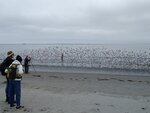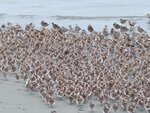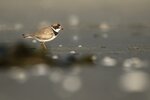


Yesterday (May 3rd) I took my own advice and journeyed to Grays Harbor to see the annual shorebird migration. I have previously written about this annual spring opportunity to witness this avian extravaganza.
We checked the tide table and then went to Bottle Beach State Park, located on Highway 105 west of Aberdeen, along the southwestern edge of Grays Harbor. This park has a long beach that remains available to shorebirds even at the highest tide when the birds are concentrated on a narrow strip of exposed beach. We were not disappointed.
There were maybe 10,000 shorebirds, sometimes spread out and sometimes gathering in a large flock. Periodically they would all arise with a loud flush of wings, circle performing an aerial ballet, and then alight nearby to continue feeding, or to take a quick nap. A thousand or more small birds landing and quickly tucking their bills under their back feathers to sleep – an impressive surprise.
Most of these shorebirds were “peeps” - small sandpipers and Dunlins that vocalize to each other with peep-like calls. On this day, the peeps were primarily Least Sandpipers, with numbers of Western Sandpipers and Dunlin mixed in.
Separate from the main flock, but still associated with it for mutual protection, were small numbers of Semipalmated Plover. When you see these cute birds, they will remind you of small Killdeer. They are smaller than robins and appear round with a stubby orange bill with a black tip. They feed along our shorelines before migrating to the Arctic for breeding. Occasionally we see these birds in winter on our Thurston County marine shorelines.
Flying in a large, mixed species flock provides shorebirds with some level of protection from avian predators, particularly falcons. We didn’t see any falcons yesterday, but when alarmed, the flock would jump up and fly in unison, only to quickly settle back on another part of the beach.
And when the flock settled close to us, with simple binoculars, we could see amazing details. This included subtle differences between the species (Dunlins are a little larger than the other peeps) and how the several species feed and otherwise act differently. A few Short-billed Dowitchers, which are quite a bit larger, were wading in deeper water on the edge of the flock. The Dunlins sometimes wandered up the beach in small numbers, venturing into drier sand and catching small insects.
There were about 20 different small groups of humans on the beach as well - most with gigantic telescopes and cameras - and what interested all of us most was a scattered number of Red Knot, a species listed as Threatened under the Endangered Species Act. In spring they have a light rusty reddish wash on their breasts, and a thin, sandpiper-like bill. They are a little larger than Dunlins. The accompanying group photo has a Red Knot in the upper right.
Because this species is threatened, it has been extensively studied. Birds are marked with color tags and, sometimes, sonic tags that report migratory patterns via satellite connections. This shorebird species is much more common along the Eastern North American coast, although small numbers migrate on the West coast as well. Yesterday we spotted two Red Knots with color tags on their legs and sent that information to a reporting site. The entire Red Knot tracking study is reported at length at this website. This information is very interesting and well worth reading.
It’s not too late to enjoy this year’s shorebird migration. When planning a visit to Bottle Beach State Park, or other shore areas, be certain to check the tide tables. The birds concentrate only during the hours around high tide. This weekend is the Grays Harbor Shorebird Festival (https://www.shorebirdfestival.com/). That event is usually crowded. If that bothers you, Bottle Beach is a good alternative. Both have a lot of experienced birders around, most of whom are more than willing to share their expertise. Next week there will be good high tides in the early morning hours. And there’s always next year – these birds follow their migration schedule faithfully every year.
Bottle Beach State Park is one of the many publicly protected habitat areas available to us to enjoy every day. If you visit Bottle Beach, or other state parks and recreation areas, you will need a Washington Discover Pass for your car. I urge you to get one as this is a major means to demonstrate our strong support for having public recreation and habitat lands. See https://www.discoverpass.wa.gov/ for purchase locations (R.E.I., for example), but the easiest way to get one is to purchase it when you relicense your car each year.
George Walter is environmental program manager at the Nisqually Indian Tribe’s natural resources department; he also has a 40+ year interest in bird watching. He may be reached at george@theJOLTnews.com
Photos for this column are provided by Liam Hutcheson, a 15-year-old Olympia area birder and avid photographer.
1 comment on this item Please log in to comment by clicking here
chezeve
I really appreciated George Walter’s informative article on shorebirds. I’ve wondered about this phenomenon for awhile & wasn’t quite certain of where to go or what to look for exactly. This answered some of my questions & piqued my interest for a road-trip! Thank you!
Friday, May 5, 2023 Report this